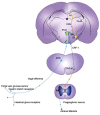Mechanisms of the blunting of the sympatho-adrenal response: a theory
- PMID: 19442093
- PMCID: PMC3405284
- DOI: 10.2174/157339909788166846
Mechanisms of the blunting of the sympatho-adrenal response: a theory
Abstract
Development of therapeutic measures to reduce the risk of potentially fatal episodes of hypoglycaemia and thus to achieve the full benefits of intensive insulin therapy in diabetic patients requires a complete understanding of the multi-factorial mechanisms for repeated hypoglycaemia-induced blunting of the sympatho-adrenal response (BSAR). After critical analysis of the hypotheses, this review paper suggests a heuristic theory. This theory suggests two mechanisms for the BSAR, each involving a critical role for the central brain noradrenergic system. Furthermore, this theory also suggests that the lateral hypothalamus (LH) plays an important role in this phenomenon. Within the framework of this theory, explanations for 1) sexual dimorphism in the adrenomedullary response (AR), 2) dissociation in the blunting of the AR and the sympathetic response (SR) and 3) antecedent exercise-induced blunting of the AR are provided. In addition, habituation of orexin-A neurons is suggested to cause defective awakening. Moreover, potential therapeutics measures have been also suggested that will reduce or prevent severe episodes of hypoglycaemia.
Figures


Similar articles
-
Recurrent insulin-induced hypoglycemia causes site-specific patterns of habituation or amplification of CNS neuronal genomic activation.Neuroscience. 2005;130(4):957-70. doi: 10.1016/j.neuroscience.2004.09.030. Neuroscience. 2005. PMID: 15652993
-
Hypoglycemia per se stimulates sympathetic neural as well as adrenomedullary activity, but, unlike the adrenomedullary response, the forearm sympathetic neural response is not reduced after recent hypoglycemia.Diabetes. 1999 Jul;48(7):1429-36. doi: 10.2337/diabetes.48.7.1429. Diabetes. 1999. PMID: 10389849
-
Evidences of a sympatho-adrenal dysfunction after lesion of the central noradrenergic pathways in rats.J Neural Transm. 1986;67(3-4):205-14. doi: 10.1007/BF01243348. J Neural Transm. 1986. PMID: 3806079
-
Normal and abnormal sympathoadrenal function; in patients with insulin-dependent diabetes mellitus.N Y State J Med. 1982 May;82(6):886-91. N Y State J Med. 1982. PMID: 7048156 Review. No abstract available.
-
Pathophysiology of sympathoadrenal system.J Endocrinol Invest. 1988 Dec;11(11):817-29. doi: 10.1007/BF03350236. J Endocrinol Invest. 1988. PMID: 3066815 Review. No abstract available.
Cited by
-
Whole genome expression profiling associates activation of unfolded protein response with impaired production and release of epinephrine after recurrent hypoglycemia.PLoS One. 2017 Feb 24;12(2):e0172789. doi: 10.1371/journal.pone.0172789. eCollection 2017. PLoS One. 2017. PMID: 28234964 Free PMC article.
-
Posttranscriptional regulation of adrenal TH gene expression contributes to the maladaptive responses triggered by insulin-induced recurrent hypoglycemia.Physiol Rep. 2015 Feb 22;3(2):e12307. doi: 10.14814/phy2.12307. Print 2015 Feb 1. Physiol Rep. 2015. PMID: 25713330 Free PMC article.
-
Differential effects of type 2 diabetes on brain glycometabolism in rats: focus on glycogen and monocarboxylate transporter 2.J Physiol Sci. 2018 Jan;68(1):69-75. doi: 10.1007/s12576-016-0508-6. Epub 2016 Dec 16. J Physiol Sci. 2018. PMID: 27987117 Free PMC article.
-
Respiration and autonomic regulation and orexin.Prog Brain Res. 2012;198:25-46. doi: 10.1016/B978-0-444-59489-1.00004-5. Prog Brain Res. 2012. PMID: 22813968 Free PMC article. Review.
-
Blockade of Acid-Sensing Ion Channels Attenuates Recurrent Hypoglycemia-Induced Potentiation of Ischemic Brain Damage in Treated Diabetic Rats.Neuromolecular Med. 2019 Dec;21(4):454-466. doi: 10.1007/s12017-019-08546-6. Epub 2019 May 27. Neuromolecular Med. 2019. PMID: 31134484 Free PMC article.
References
-
- Cryer PE. Mechanisms of hypoglycaemia-associated autonomic failure and its component syndromes in diabetes. Diabetes. 2005; 54(12):3592–601. - PubMed
-
- Cryer PE, Childs BP. Negotiating the Barrier of Hypoglycemia in Diabetes. Diabetes Spectr. 2002;15(1):20–7.
-
- Levin BE, Sullivan AC. Glucose, insulin and sympathoadrenal activation. Auton Nerv Syst. 1987;20(3):233–42. - PubMed
-
- Towler DA, Havlin CE, Craft S, Cryer PE. Mechanism of awareness of hypoglycaemia: perception of neurogenic (predominantly cholinergic) rather than neuroglycopenic symptoms. Diabetes . 1993;42:1791–8. - PubMed
-
- Bolli GB. Counterregulatory mechanisms to insulin-induced hypoglycemia in humans: relevance to the problem of intensive treatment of IDDM. J Pediatr Endocrinol Metab. 1998;11(1):103–15. - PubMed
Publication types
MeSH terms
Substances
LinkOut - more resources
Full Text Sources
Medical
Research Materials
